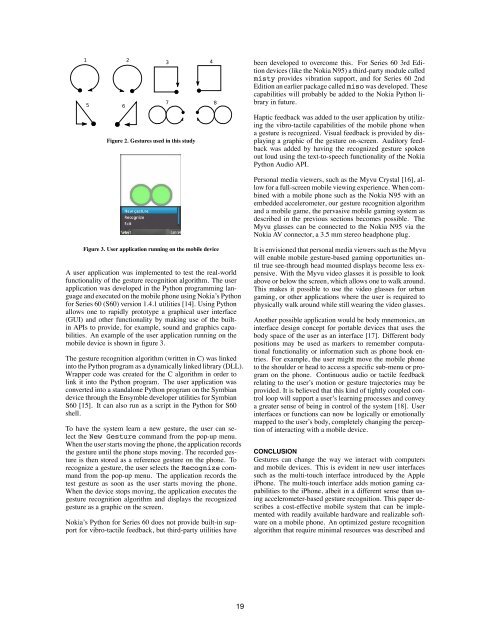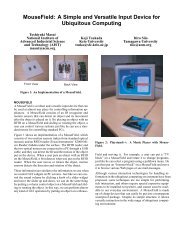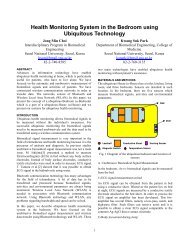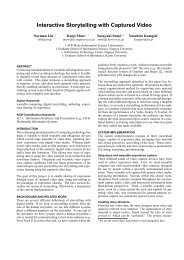Workshops - UbiComp
Workshops - UbiComp
Workshops - UbiComp
- No tags were found...
Create successful ePaper yourself
Turn your PDF publications into a flip-book with our unique Google optimized e-Paper software.
een developed to overcome this. For Series 60 3rd Editiondevices (like the Nokia N95) a third-party module calledmisty provides vibration support, and for Series 60 2ndEdition an earlier package called miso was developed. Thesecapabilities will probably be added to the Nokia Python libraryin future.Figure 2. Gestures used in this studyHaptic feedback was added to the user application by utilizingthe vibro-tactile capabilities of the mobile phone whena gesture is recognized. Visual feedback is provided by displayinga graphic of the gesture on-screen. Auditory feedbackwas added by having the recognized gesture spokenout loud using the text-to-speech functionality of the NokiaPython Audio API.Personal media viewers, such as the Myvu Crystal [16], allowfor a full-screen mobile viewing experience. When combinedwith a mobile phone such as the Nokia N95 with anembedded accelerometer, our gesture recognition algorithmand a mobile game, the pervasive mobile gaming system asdescribed in the previous sections becomes possible. TheMyvu glasses can be connected to the Nokia N95 via theNokia AV connector, a 3.5 mm stereo headphone plug.Figure 3. User application running on the mobile deviceA user application was implemented to test the real-worldfunctionality of the gesture recognition algorithm. The userapplication was developed in the Python programming languageand executed on the mobile phone using Nokia’s Pythonfor Series 60 (S60) version 1.4.1 utilities [14]. Using Pythonallows one to rapidly prototype a graphical user interface(GUI) and other functionality by making use of the builtinAPIs to provide, for example, sound and graphics capabilities.An example of the user application running on themobile device is shown in figure 3.The gesture recognition algorithm (written in C) was linkedinto the Python program as a dynamically linked library (DLL).Wrapper code was created for the C algorithm in order tolink it into the Python program. The user application wasconverted into a standalone Python program on the Symbiandevice through the Ensymble developer utilities for SymbianS60 [15]. It can also run as a script in the Python for S60shell.To have the system learn a new gesture, the user can selectthe New Gesture command from the pop-up menu.When the user starts moving the phone, the application recordsthe gesture until the phone stops moving. The recorded gestureis then stored as a reference gesture on the phone. Torecognize a gesture, the user selects the Recognize commandfrom the pop-up menu. The application records thetest gesture as soon as the user starts moving the phone.When the device stops moving, the application executes thegesture recognition algorithm and displays the recognizedgesture as a graphic on the screen.Nokia’s Python for Series 60 does not provide built-in supportfor vibro-tactile feedback, but third-party utilities haveIt is envisioned that personal media viewers such as the Myvuwill enable mobile gesture-based gaming opportunities untiltrue see-through head mounted displays become less expensive.With the Myvu video glasses it is possible to lookabove or below the screen, which allows one to walk around.This makes it possible to use the video glasses for urbangaming, or other applications where the user is required tophysically walk around while still wearing the video glasses.Another possible application would be body mnemonics, aninterface design concept for portable devices that uses thebody space of the user as an interface [17]. Different bodypositions may be used as markers to remember computationalfunctionality or information such as phone book entries.For example, the user might move the mobile phoneto the shoulder or head to access a specific sub-menu or programon the phone. Continuous audio or tactile feedbackrelating to the user’s motion or gesture trajectories may beprovided. It is believed that this kind of tightly coupled controlloop will support a user’s learning processes and conveya greater sense of being in control of the system [18]. Userinterfaces or functions can now be logically or emotionallymapped to the user’s body, completely changing the perceptionof interacting with a mobile device.CONCLUSIONGestures can change the way we interact with computersand mobile devices. This is evident in new user interfacessuch as the multi-touch interface introduced by the AppleiPhone. The multi-touch interface adds motion gaming capabilitiesto the iPhone, albeit in a different sense than usingaccelerometer-based gesture recognition. This paper describesa cost-effective mobile system that can be implementedwith readily available hardware and realizable softwareon a mobile phone. An optimized gesture recognitionalgorithm that require minimal resources was described and19






